![]()
![]()
![]()
Use LEFT and RIGHT arrow keys to navigate between flashcards;
Use UP and DOWN arrow keys to flip the card;
H to show hint;
A reads text to speech;
40 Cards in this Set
- Front
- Back
- 3rd side (hint)
|
DLD services |
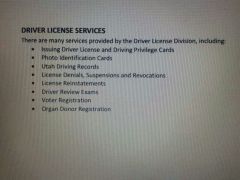
|
Registration. Cards. Exams. |
|
|
DLD history |
The Bureau of Driver License Services created January 1, 1934 - no exam until January 1, 1935 - DLD began CDL in 1989 - DLD not part of DMV |
|
|
|
Top 5 Leading Causes of Crashes on Utah Highways |
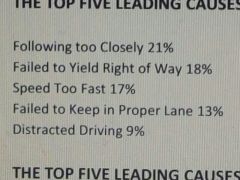
|
Following closely, failed right of way, speeding, improper lane, distracted |
|
|
Top 5 Leading Causes of Death on Utah Highways (teenagers) |
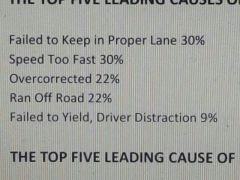
|
Improper lane, speeding, overcorrected, ran off road, failed to yield, distracted |
|
|
Topb5 Leading Causes of Crashes on Utah Highways (teenagers) |
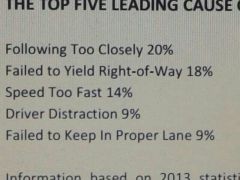
|
Too close, failed right of way, speeding, distracted, improper lane |
|
|
Assumption of Financial Responsibility |
An adult signing for liability for civil damages caused by a minor when operating a motor vehicle |
Adult liable for minor causing damage |
|
|
Commercial Driver License |
A license which allows the holder to drive a vehicle with a GVWR of 26,001 lbs or more, or designed to transport 16 or more passengers, hazardous materials, doubles/triples, bulk liquids, or school buses |
|
|
|
Driving Privilege Card |
The evidence of the privilege to drive a motor vehicle in Utah which was obtained without providing proof of lawful presence in U.S. |
|
|
|
Low Speed Vehicle |
A four-wheeled electric motor vehicle designed to be operated at speeds of not more than 25 mph and that has a capacity of not more than four passengers, including the driver. (Does not include a golf cart or off-highway vehicle) |
|
|
|
Motor Vehicle |
Every self-propelled vehicle, except motorized wheelchairs, electric personal assistive mobility device and vehicles moved solely by human power |
|
|
|
Mobility Vehicle |
A vehicle used by a person with a physical disability which meets the specifications outlined by the division and can be operated on a public roadway, within appropriate restrictions and by an individual who holds a valid Mobility Vehicle Permit |
|
|
|
Mobility Vehicle Permit |
A permit issued by the division which grants authority and specifies the conditions for a person with a physical disability to drive a mobility vehicle on a public highway |
|
|
|
Provisional License |
A Utah license issued to any person under 21 years of age |
<21 |
|
|
Written Test |
Road signs, Written questions (specific to class of license, safe driving practices, driving and traffic laws, license sanctions) |
|
|
|
Skills (Driving) Test |
Road rules and regulations, proper driving techniques, general behavior and attitude, driving posture, proper use of lanes, left and right turns, starting and stopping, parking on hills and between cars, observance of traffic signs and signals, back U-turns and steering coordination, attention at intersections, and overall ability to operate the vehicle safely and appropriately |
|
|
|
Education Requirement |
19 years of age or older: driver education course not required if they hold a Utah learner permit for at least 3 months and complete 10 hours of night driving and 40 hours altogether driving experience |
|
|
|
Endorsement Codes |
H - Hazardous Materials M - Motorcycles N - Tankers P - Passengers S - School Bus T - Doubles and Triple Trailers X - Hazmat and Tankers Z - Taxicab |
|
|
|
Restrictions |
A - No restrictions B - Driver must wear corrective lenses C - Mechanical aid must be used while driving D - Prosthetic aid must be used while driving E - Restricts the driver from diving a commercial motor vehicle with a manual transmission F - Restricted to driving a vehicle with outside rearview mirrors G - Restricted to driving during daylight hours only J - Restricts the driver for any other restrictions deemed necessary by the Division K - Restricted to intrastate operation of commercial vehicles L - Restricted to vehicles with no air brakes M - Restricts driver from transporting passengers using a Class A bus N - Restricts a driver from transporting passengers using a Class A or Class B bus O - Restricts a driver from driving a commercial motor vehicle equipped with a tractor trailer P - Restricts a CDL driver with a school bus or passenger endorsement from having passengers in a commercial motor vehicle U - Restricted to operate only three-wheeled motorcycles V - Indicates that the driver has been issued a variance by the Federal Motor Carrier Safety Administration in reference to the driver's medical certification status Z - Restricts a driver from driving a commercial motor vehicle with non-fully equipped air brakes 1 - Driver required to have an ignition interlock device installed while operating a vehicle 2 - Restricted to operating a motorcycle <250 cc 3 - Restricted to operating a motorcycle <650 cc 4 - Restricted to operating a street legal ATV 5 - Restricted to operating a motorcycle <90 cc 6 - Restricted to operating a vehicle on roads with a posted speed limit of 40 mph or less 7 - Restricts driver to operating a motor vehicle with an automatic transmission |
|
|
|
Required Documents |
Identity and Legal/Lawful Status Verification, Social Security Verification, Utah Residency Address Verification (x2) |
|
|
|
Rear Facing Child Seat |
Until at least age 2, 30+ lbs |
|
|
|
Forward Facing Child Seat (with harness) |
Until at least age 4, 40+ lbs |
|
|
|
Booster Child Seat |
4 years/40 lbs/4' 9" |
|
|
|
Signaling |
Two seconds before turning, two seconds before lane change, when pulling away from curb |
|
|
|
Hand signals |

|
|
|
|
20 mph |
When passing a school building or grounds, while children are going to or leaving school during opening or closing hours or when flashing lights are operating |
|
|
|
25 mph |
In any business or residential area |
|
|
|
55 mph |
On major highways, as posted |
|
|
|
65, 70, 75, 80 mph |
On rural Highways, as posted |
|
|
|
Slow down |
When highway marked, when approaching and crossing an intersection or railroad crossing, when approaching and going around a curve, when approaching the top of a hill, when traveling upon any narrow or winding road, when special hazards exist, during poor weather, anytime you cannot see clearly, where construction, maintenance or utility work is being done, when approaching any vehicle with flashing lights |
|
|
|
Right-of-Way |
A driver who is at the intersection before you, drivers in opposite lane when you are turning left, the driver on your right at a four-way stop if you arrive at the same time, drivers on a public road if you are coming from a driveway or private road, drivers already on an interstate highway if you are on the entrance ramp, pedestrians, bicyclists and others still on the intersection |
|
|
|
Traffic lights |
Green - you may go through with caution if the way is clear Yellow - the light is about to change to red Red - you must stop before entering the intersection, you must wait behind the stop line, crosswalk or intersection until the light turns green. You may make a right turn after coming to a full and complete stop unless otherwise posted Flashing yellow - slow down and prices with caution Flashing yellow arrow - turns are permitted but first yield to incoming traffic and pedestrians. Proceed with caution! Flashing red - stop and look both ways before entering the intersection |
|
|
|
Yellow Lane markings (single dashed) |
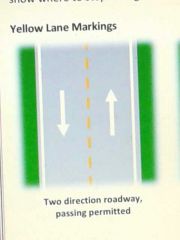
|
|
|
|
Yellow Lane markings (dash/solid) |
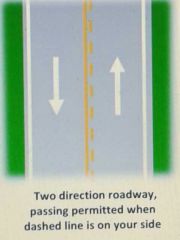
|
|
|
|
Yellow Lane markings (double solid) |
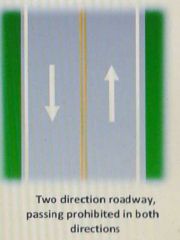
|
|
|
|
White Lane markings |
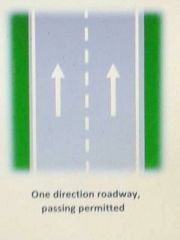
|
|
|
|
Crosswalk and Stop Lines |
At a stop sign or signal, you must stop behind the stop line or crosswalk. If crosswalks are not marked then you must stop before the intersection or stop sign. If there's a stop line before the crosswalk then you must stop at the stop line. Always yield to pedestrians! |
|
|
|
Shared Center Left Turn Lane |
May not enter lane more than 500 ft prior to turning unless the last car in line is more than 500 ft from the intersection. |
|
|
|
When turning |
Check for traffic controls, pedestrians, and other vehicles Signal at least 2 seconds in advance of turn Enter the closest lane in the direction you want to go Look as far as you can through the turn Accelerate smoothly, cancel turn signal and check to rear |
|
|
|
Right turn |
Signal right for 2 seconds Do not swing wide to the left before a right turn Always turn right from the right side of your lane |
|
|
|
Top 5 Leading Causes of Death on Utah Highways |
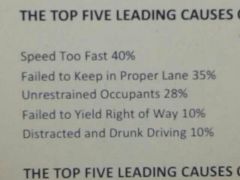
|
Speeding, improper lane, unrestrained, failed right of way, distracted/drunk |

